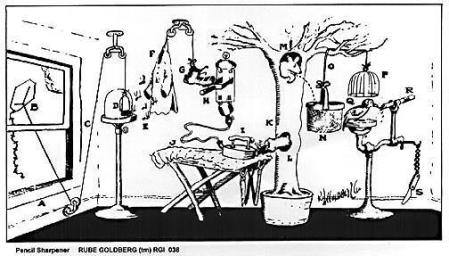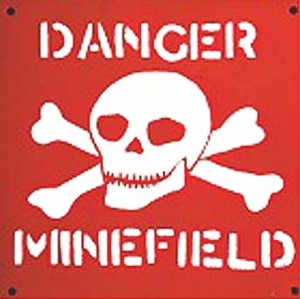 It’s been one of those weird weeks when the moon should have been full. But it wasn’t. Perhaps the 100 plus degree heat an 99.999997% humidity have steamed the brains of Middle Georgians. Poor Richard doesn’t know exactly what it is, but things are slightly askew here . . . to paraphrase my buddy Bob Galloway, the curmudgeon, the entire town is about “half a bob off plumb.”
It’s been one of those weird weeks when the moon should have been full. But it wasn’t. Perhaps the 100 plus degree heat an 99.999997% humidity have steamed the brains of Middle Georgians. Poor Richard doesn’t know exactly what it is, but things are slightly askew here . . . to paraphrase my buddy Bob Galloway, the curmudgeon, the entire town is about “half a bob off plumb.”
Item One
I didn’t get to meet her, but right hand man Brian said that she looked relatively normal when she walked through the doors of the printshop behind the red awnings on Poplar (name carefully concealed to avoid disrupting the peaceful sleep of the powers that be at the franchise . . . hint, sounds like Gralpharaphics). She explained to Brian that she was opening a new business and needed letterhead, envelopes, business card, etc. This used to be a fairly common occurrence at printing companies, and Brian looked forward to serving a new customer.
It’s not uncommon that a new customer will ask the price of a product before they provide a description of it. While it is possible to quote a price that will cover most contingencies, I’ve yet to find a customer who will accept an estimate of “probably somewhat less than $10,000,” without question. Standard operating procedure is to try to narrow the description a bit and find a solution that is reasonably in line with the customer’s expectations and budget.
Brian attempted and ascertained that the customer would like to use paper for her letterhead and envelopes and would also like her symbol on it. She specifically said “symbol,” not logo or wordmark or even image. She wanted her symbol on the letterhead . . . in color . . . and (as she glanced and pointed at a presentation folder on our display rack) “smashed into the paper like that.”
Skeptical that the cost of embossing a process color logo on a short run of letterhead would be practical for a new business, Brian started to suggest alternatives. The customer was adamant. What she wanted was her symbol smashed into the letterhead, business cards and envelopes. Ever helpful, Brian offered to run down prices and asked if the customer had her logo as a digital file that we could use . . . or at least something that we could look at to help us prepare the estimate. The customer fumbled a bit, then reached in her purse, removed her billfold and then her drivers license.
“That’s it,” she exclaimed, pointing at the photo on the license. “That’s my symbol. That’s what I want!”
Brian, ever mindful of the endless time and patience available to the printshop owner, deferred to Poor Richard and told the customer that I would follow up with her. I haven’t contacted her yet, but I do have an idea. Perhaps something like this might work?
Item Two
Three paragraphs, bullet points, and numbers. Poor Richard is probably going to get in big trouble with this one, because the customer is going to read this blog, identify himself, and get supremely ticked off!
Here’s the text of the email we received:
Whereas, from time to time revisions are made to documents created for Amalgamated Peanut Butter and Jelly Roll Company (APB&J Rollco), and said documents are printed and archived by Gralpharaphics of Macon, the aforesaid company (APB&J Rollco) wishes to indicate the occurrence of revisions to each document produced and to verify the currency of each revision prior to production of duplications, reprints, or new and unique iterations of each printed version or versions.
Because the temporality of the aforementioned documents is currently not indicated, this may currently counterindicate the currency of our current versions. In fact, our customers have occasionally called the currency of our current versions into question due to the lack of an evidential indicant that the version they received was indeed correct and produced contemporaneously with the latest APB&J Rollco product described within.
Our goals are thus:
- to accurately indicate the current version
- to convey this clearly to our customers
- to assure that the latest iteration of each document is indeed the current version
- (to confuse the pants off of the folks at Gralpharaphics)
To that end we require that your company immediately implement the following changes as pertain to the documents and versions of documents you currently produce, have produced in the past, or might conceivably produce in the future for APB&J Rollco:
- Indicate the current version on the document
- Do this in such a way that the temporality of the version is conveyed to each customer
- Destroy, delete, or otherwise dispense with document versions that are untemporal or not current
Many thanks for the services you render for APB&J Rollco and for your prompt attention to this matter.
–Name withheld in the vain hope that Poor Richard will go undiscovered.
Admittedly, Poor Richard has elaborated a bit . . . but not a lot. The actual email we received from our good, but very precise, customer was almost as complicated as the gobbledygook inserted above and did require a phone call to ascertain exactly what the customer wanted . . . a date entry at the bottom of each form we produce to indicate the latest revision.
Item Three
The customer was absolutely serious. So serious in fact that he noted a specific instruction on the proof copy that he faxed back to us and on his email approval of the final proof. We’ve produced shells similar to the one the customer wanted many times. A shell is boilerplate language (and sometimes a form image) that can be fed through a laser printer to overprint the specifics of a contract, invoice, etc.
In this case, we were asked to print 5000 copies on one side. Presumably the specifics would be printed on the other. There was no specific paper requirement . . . we printed on 60# offset text (no watermarks).
The instruction: Please make sure that this information is printed on the back of the paper.
I think we did OK. We stacked all 5000 copies printed side down in the boxes and delivered them to the customer. He thought we were wonderful!
Times are still rough in the printing business, but it laughter is a great diversion. Isn’t life grand?
 I came across this odd photo of a school bus in Google Images and felt like it was fairly representative of life during these past months . . . completely impossible to figure out which end should be up.
I came across this odd photo of a school bus in Google Images and felt like it was fairly representative of life during these past months . . . completely impossible to figure out which end should be up.


 Posted by poor richard
Posted by poor richard 








